Sometimes the less things change, the better they remain. Take Yamaha’s FJR1300, for example. The bike was introduced here for 2004, a sport-touring road burner with removable hard saddlebags, electrically adjustable windscreen and a 1,298cc 4-cylinder, liquid-cooled engine with 5-speed transmission and shaft final drive. Granted, the first model vented an excessive amount of heat toward the rider, but a fairing and ducting redesign soon fixed that annoyance. Since then, the FJR has continued with minimal but functional changes and remains true to its core while adding safety, comfort and convenience features over the years.
The 2012 edition of the FJR remains powered by that liquid-cooled, in-line, transversely mounted 4-cylinder motor with dual overhead cams and four valves per cylinder. It inhales through a brace of throttle bodies with electronic fuel injection. Likewise, it also retains the 5-speed transmission and shaft final drive, all mated to an aluminum frame and swingarm with the engine as a stressed member. Despite the aluminum bits, the FJR remains pretty hefty at 668 pounds wet, and it’s a grunt to hoist the bike up onto its centerstand.
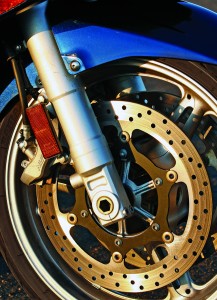
Our test FJR appeared just as I was planning a trip from my home in Southern California to Sequoia National Park about 350 miles to the north, and with at potent sport tourer available, I decided to ride all the curvy roads I could find between points A and B. Packing for the trip was simplified by the FJR’s lockable and easily removable saddlebags with internal dimensions of 17 inches long, 12 inches high and 9-10 inches deep at their widest points. The bags unlock with the ignition key, open easily, but may require some coaxing to close. They feature internal retaining straps and either bag will hold a full-face helmet. If you wish to carry the bags into your tent or motel room they’re easily removable by unlocking and lifting the pop-up handle; reinstallation is just as easy. A small luggage rack and passenger grab bar add to convenience, but since I was riding solo my main bag loaded with camping gear stayed on the rear portion of the seat. Incidentals go in the small locking compartment in the left side of the fairing, and the steel fuel tank will accommodate a large magnetic tankbag.
With the bike loaded, I headed up my favorite twisty roads—Highway 33 out of Ojai, then east on Lockwood Valley Road. I noted that the bike felt very stable and solid in the sweeping turns, but with its 60.8-inch wheelbase and rake/trail figures of 26 degrees/4.3 inches, it required some effort to change direction in the slow second-gear turns. Shifting was easy and precise, and the hydraulically actuated clutch required a moderate pull.
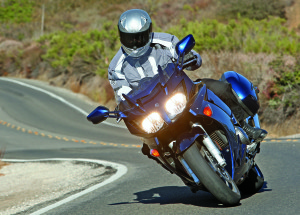
With a wide bore of 79mm and a short stroke of 66.2mm you might expect the engine to be a revver, but with a powerband that ranges from 2,000 rpm all the way up to its 9,000-rpm redline, it takes on the torque characteristics of a big-bore motor. While decelerating into Lockwood Valley’s numerous tight turns, the big engine had no problem idling down to as low as 2,000 rpm in the lower gears, then pulling away without a murmur. When we put our 2010 FJR1300 test bike on the Jett Tuning dyno, it made 125.2 horsepower at 8,100 rpm at the rear wheel, and 88 lb-ft of torque at 6,900.
Some riders might question why, while most modern bikes utilize a 6-speed transmission, the FJR makes do with a 5-speed. After having put a couple thousand miles on the bike, I can attest that it doesn’t need that extra gear. Multi-speed trannies flourished as bikes became more powerful and powerbands narrowed, but with the FJR offering power from the basement to the penthouse, well, who needs the extra shifting?
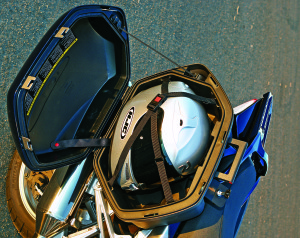
On my ride up to Sequoia, the only dull portion of the trip was the mostly straight 60 miles from Frazier Park to the small town of Arvin. The rider’s portion of the seat can be placed in either of two positions, one an inch higher than the other, and the individual alloy handlebars can be rotated to any of three positions. These can be adjusted to allow the rider to stretch out on the straight stretches, and then possibly hunker down closer to the machine for the twisties.
The single, most-useful feature for many sport-touring riders will be the electrically adjustable windscreen, which, with the push of a button near the left grip, can slide up to five additional inches from its lowest to its highest position, or it can be parked anywhere in between. Set low, it shunts the windblast to the middle of the rider’s chest, and as the screen rises the wind noise and pressure on the rider change dramatically. I rode in everything from cool weather to 100-degree heat and a brief downpour, during which the lowered screen gave me plenty of airflow, while in the momentary rain the fairing and windscreen in its highest position kept my chest, hands and legs dry.
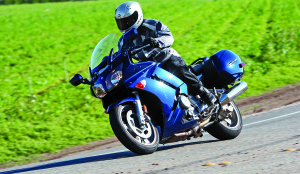
Lunch was north of Kernville at the rustic Brewer’s Ponderosa Lodge at an elevation of around 7,000 feet. While descending the long, twisty downhill section north from there, I was relieved that Yamaha has given the FJR powerful, integrated anti-lock brakes, with each of its front 320mm discs gripped by a four-piston caliper. While ABS was optional on early FJRs, it is now standard. Pulling the front brake lever activates three of the four pistons on each of the twin front rotors. Utilizing the rear brake pedal activates not only the two pistons on the 282mm rear disc, but also the fourth piston on each front rotor. The brakes are powerful, precise, and easily modulated and controllable. The clutch and brake levers are both equipped with an adjustment wheel to dial in the reach, and the ABS was a comfort on roads that were frequently sandy.
After a couple hundred miles, the stock seat was feeling narrow and stiff, and by the end of that 375-mile day I was ready to get off the bike. With its dual gear-driven counterbalancers, the motor remained smooth and I had no problem with vibration or my hands falling asleep while riding.
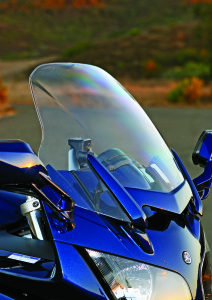
The FJR’s engine likes to rev and snort, but was also very well mannered at low speeds, including while maneuvering the uncertain traction of the campground access road. The bike provides very good balance as soon as the clutch is released, and is easy to maneuver at low speeds. Still, with its long wheelbase, it requires some distance to turn around in tight places.
It was cool that September morning when I awoke in the campground in Sequoia National Park situated at more than 7,000 feet elevation. As I rode among the tall trees toward Hume Lake, I really appreciated the FJR’s amenities. As a sport tourer, it offers heated handgrips with rheostat control, though the owner’s manual contains the curious warning, “Do not turn the grip warmer knob while the vehicle is moving.” This is legalese meant to address rider inattention rather than any mechanical consideration. The grips worked well and offered a wide range of warmth.
As loads change it may become necessary to adjust the headlights, and the FJR offers a separate adjuster for each of its dual cat eye lights. There is also a power outlet inside the previously mentioned storage compartment for a phone, GPS or heated clothing.
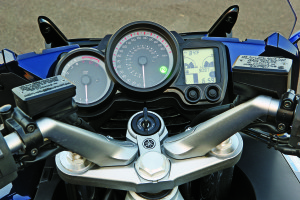
The rider can set the FJR’s fully adjustable suspension for every eventuality from solo and empty to two-up and loaded. On the left side of the bike, just above the swingarm, a sliding lever adjusts spring preload on the rear shock. An adjusting knob at the base of the shock sets rebound damping. The fork provides not only for spring preload on each leg, but also for compression and rebound damping. I was easily able to dial them in for whatever type of riding I was doing, or the load I was carrying.
With its 10.8:1 compression ratio, the FJR dines upon 91-octane premium fuel, and on my trip (combined with local riding), returned a reasonable 41.3 mpg. A sport tourer requires good fuel capacity and with 6.6 gallons aboard, the FJR could take me more than 270 miles on a single tank.
I put close to 2,000 miles on the FJR during my test, and the bike had nearly 3,000 miles on it when I reluctantly returned it to Yamaha. I noted that with my riding on mostly fast, twisty roads and the bike’s heavy, low-speed steering the front Bridgestone Battlax BT021 tire was already worn to near its wear bars and was in need of replacement. Its rear Battlax, however, still had a lot of miles left in it. Keep in mind that your tire usage will likely be different.
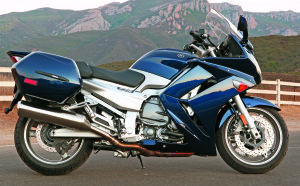
Some bikes survive on finesse while others depend upon their brute strength; the FJR is among the latter. Still, it’s a velvet brute, big and fast, and its suspension is adequate—firm and abrupt rather than plush, but well controlled. Its seat isn’t cushy and the bike is not nimble in tight turns, but it’s stable in third-gear-and-higher turns. At $15,590 in the Cobalt Blue shown (the only color available this year) it’s certainly not inexpensive, but the FJR survives based upon its great motor and long list of amenities.
To learn more about accessories you can get for your Yamaha FJR1300, read our Better Boingers article here.
2012 Yamaha FJR1300
Base Price: $15,590
Warranty: 1 yr., unltd. miles
Website: yamaha-motor.com
Engine
Type: Liquid-cooled, transverse in-line four
Displacement: 1,298cc
Bore x Stroke: 79.0 x 66.2mm
Compression Ratio: 10.8:1
Valve Train: DOHC, four valves per cyl.
Valve Adj. Interval: 26,000 miles
Fuel Delivery: Electronic Fuel Injection
Lubrication System: Wet sump, 4-qt. cap.
Transmission: 5-speed, hydraulically actuated wet clutch
Final Drive: Shaft, 2.773:1
Electrical
Ignition: Digital TCI
Charging Output: 490 watts @ 5,000 rpm
Battery: 12V 12AH
Chassis
Frame: Diamond type twin-spar aluminum w/ engine as stressed member & aluminum swingarm
Wheelbase: 60.8 in.
Rake/Trail: 26 degrees/4.3 in.
Seat Height: 31.7/32.5 in.
Suspension, Front: 48mm stanchions, fully adj., 5.3-in. travel
Rear: Single shock, adj. for spring preload & rebound damping, 4.9-in. travel
Brakes, Front: Dual discs w/ opposed 4-piston calipers & ABS
Rear: Single disc w/ 2-piston caliper linked to front, & ABS
Wheels, Front: Cast, 3.50 x 17 in.
Rear: Cast, 5.50 x 17 in.
Tires, Front: 120/70-ZR17
Rear: 180/55-ZR17
Wet Weight: 668 lbs.
Load Capacity: 441 lbs.
GVWR: 1,109 lbs.
Performance
Fuel Capacity: 6.6 gals., last 1.3 gals. warning light on
MPG: 86 PON min. (low/avg/high) 34.0/41.3/47.6
Estimated Range: 270 miles
Indicated RPM at 60 MPH: 3,000
(This article Velvet Brute was published in the December 2012 issue of Rider magazine.)








in the old one ,The manual says use regular – 87 pump octane.
La mia compagna di viaggio per l’Europa. Modello 2001 blu come quella della prova. Compagna di viaggio per tutto l’ arco dell’ anno e in ogni condizione atmosferica, Insieme abbiamo calpestato 125.000 km sempre affidabile dovevo solo alimentarla con benzina olio e gomme. Sono rimasto contento della sua compagnia, a parte quella propensione a scaldarmi le parti “basse”, che d’ inverno può essere piacevole ma nelle torridi estati…
None of the FJR1300’s have required “premium” gasoline. The manual states that it needs a minimum of R+M/2 of 86 or 91 RON (research octane). In the US we use R+M/2 or AKI method, which is the average of RON and MON. Europe uses RON, and 91 is regular there, and corresponds to the AKI 86.
Thanks for pointing that out David. You are correct and we have made the change in the spec chart of the article.